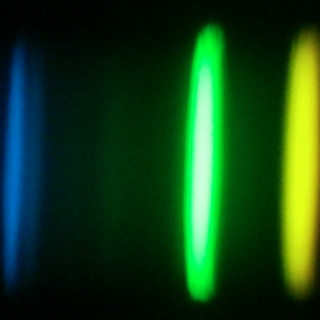Aguado, D. S.; Molaro, P.; Caffau, E.; González Hernández, J. I.; Zapatero Osorio, M. R.; Bonifacio, P.; Allende Prieto, C.; Rebolo, R.; Damasso, M.; Suárez Mascareño, A.; Howell, S. B.; Furlan, E.; Cristiani, S.; Cupani, G.; Di Marcantonio, P.; D'Odorico, V.; Lovis, C.; Martins, C. J. A. P.; Milakovi, D.; Murphy, M. T.; Nunes, N. J.; Pepe, F.; Santos, N. C.; Schmidt, T. M.; Sozzetti, A.
Referencia bibliográfica
Astronomy and Astrophysics
Fecha de publicación:
12
2022
Revista
Número de citas
18
Número de citas referidas
16
Descripción
Context. HE 0107−5240 is a hyper metal-poor star with [Fe/H] = −5.39, one of the lowest-metallicity stars known. Its stellar atmosphere is enhanced in carbon, with [C/Fe] = +4.0, without a detectable presence of neutron-capture elements. Therefore, it belongs to the carbon-enhanced metal-poor (CEMP−no) group, along with the majority of the most metal-poor stars known to date. Recent studies have revealed variations in the line-of-sight velocity of HE 0107−5240, suggesting it belongs to a binary system. CEMP-no stars are the closest descendants of the very first Pop III stars, and binarity holds important clues for the poorly known mechanism that leads to their formation.
Aims: We performed high-resolution observations with the ESPRESSO spectrograph at the VLT to constrain the kinematical properties of the binary system HE 0107−5240 and to probe the binarity of the sample of the eight most metal-poor stars with [Fe/H] ≤ −4.5.
Methods: Radial velocities are obtained by using a cross-correlation function in the interval 4200−4315 Å , which contains the relatively strong CH band, against a template that could be either a synthetic spectrum or a combined observed spectrum in an iterative process. A Bayesian method is applied to calculate the orbit using the ESPRESSO measurements and others from the literature. Chemical analysis has also been performed for HE 0107−5240, employing spectral synthesis with the SYNTHE and ATLAS codes.
Results: Observations of HE 0107−5240 spanning more than 3 years show a monotonic decreasing trend in radial velocity at a rate of approximately 0.5 m s−1 d−1. A maximum vrad was reached between March 13, 2012, and December 8, 2014. The period is constrained at Porb = 13009−1370+1496 d. New, more stringent upper limits have been found for several elements: (a) [Sr/Fe] and [Ba/Fe] are lower than −0.76 and +0.2, respectively, confirming the star is a CEMP-no; (b) A(Li) < 0.5 is well below the plateau at A(Li) = 1.1 found in the lower red giant branch stars, suggesting Li was originally depleted; and (c) the isotopic ratio 12C/13C is 87 ± 6, showing very low 13C in contrast to what is expected from a `spinstar' progenitor.
Conclusions: We confirm that HE 0107−5240 is a binary star with a long period of about 13 000 d (∼36 yr). The carbon isotopic ratio excludes the possibility that the companion has gone through the asymptotic giant branch phase and transferred mass to the currently observed star. The binarity of HE 0107−5240 implies that some of the first generations of low-mass stars formed in multiple systems and indicates that the low metallicity does not preclude the formation of binaries. Finally, a solid indication of vrad variation has also been found in SMSS 1605−1443.
Aims: We performed high-resolution observations with the ESPRESSO spectrograph at the VLT to constrain the kinematical properties of the binary system HE 0107−5240 and to probe the binarity of the sample of the eight most metal-poor stars with [Fe/H] ≤ −4.5.
Methods: Radial velocities are obtained by using a cross-correlation function in the interval 4200−4315 Å , which contains the relatively strong CH band, against a template that could be either a synthetic spectrum or a combined observed spectrum in an iterative process. A Bayesian method is applied to calculate the orbit using the ESPRESSO measurements and others from the literature. Chemical analysis has also been performed for HE 0107−5240, employing spectral synthesis with the SYNTHE and ATLAS codes.
Results: Observations of HE 0107−5240 spanning more than 3 years show a monotonic decreasing trend in radial velocity at a rate of approximately 0.5 m s−1 d−1. A maximum vrad was reached between March 13, 2012, and December 8, 2014. The period is constrained at Porb = 13009−1370+1496 d. New, more stringent upper limits have been found for several elements: (a) [Sr/Fe] and [Ba/Fe] are lower than −0.76 and +0.2, respectively, confirming the star is a CEMP-no; (b) A(Li) < 0.5 is well below the plateau at A(Li) = 1.1 found in the lower red giant branch stars, suggesting Li was originally depleted; and (c) the isotopic ratio 12C/13C is 87 ± 6, showing very low 13C in contrast to what is expected from a `spinstar' progenitor.
Conclusions: We confirm that HE 0107−5240 is a binary star with a long period of about 13 000 d (∼36 yr). The carbon isotopic ratio excludes the possibility that the companion has gone through the asymptotic giant branch phase and transferred mass to the currently observed star. The binarity of HE 0107−5240 implies that some of the first generations of low-mass stars formed in multiple systems and indicates that the low metallicity does not preclude the formation of binaries. Finally, a solid indication of vrad variation has also been found in SMSS 1605−1443.
Based on ESPRESSO guaranteed time observations collected at the European Southern Observatory under ESO programmes 1102.C-0744, 0103.D-0700, 0104.D-0688, 1104.C-0350, and 108.2268.001 (P.I. P. Molaro).
Proyectos relacionados

Abundancias Químicas en Estrellas
La espectroscopía de estrellas nos permite determinar las propiedades y composiciones químicas de las mismas. A partir de esta información para estrellas de diferente edad en la Vía Láctea es posible reconstruir la evolución química de la Galaxia, así como el origen de los elementos más pesados que el boro, forjados principalmente en los interiores
Carlos
Allende Prieto